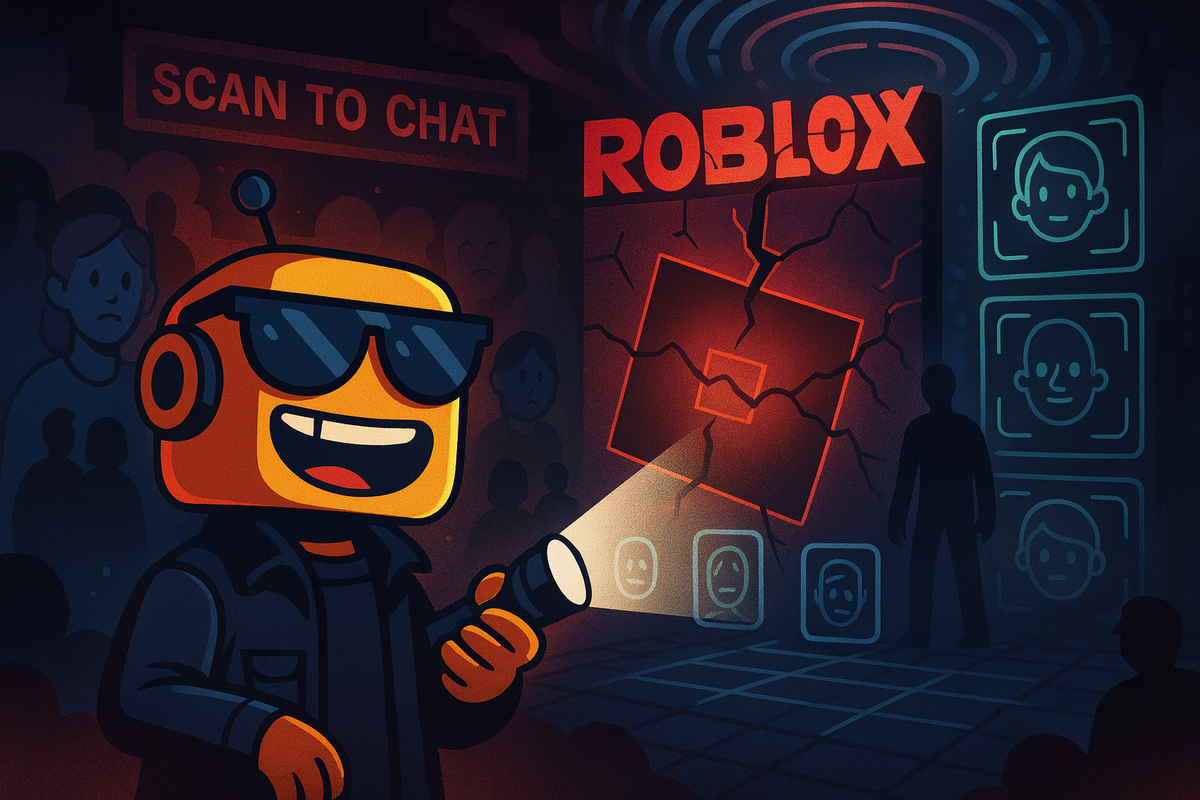Roblox’s Face-Scan Safety Theater Is Even Worse When You Hear the CEO Explain It
Roblox’s CEO says face scans and A.I. make kids safer. Lawsuits, predators, and biometric “safety theater” suggest otherwise. Here’s why parents shouldn’t buy it.

If you’ve ever wondered what it sounds like when a multibillion-dollar “kids’ platform” tries to spin a safety crisis into a growth story, The New York Times just gave you the full audio tour. And if you read SiliconSnark’s earlier breakdown — Roblox: The Lottery That Trains Kids to Spend, Not Win — this new interview isn’t a curveball. It’s just the same casino, now with mandatory face scans and a TED Talk about “innovation.”
The setup: Roblox, facing three state AG lawsuits (Louisiana, Kentucky, Texas) and dozens of private suits for allegedly failing to protect kids from predators and exploitation, has rolled out AI-powered facial age estimation so users can chat.
The Times asked CEO David Baszucki about child safety. It did, in fact, get tense — but not in the cathartic, “wow, he finally owned up to anything” way. More like watching a guy slowly try to pivot from “playground for predators” allegations to “isn’t our engagement mind-boggling?” without ever passing through “accountability.”
“We Don’t See a Problem, We See an Opportunity”
(Buddy, read the room.)
Early in the interview, when asked about predators on Roblox, Baszucki basically reframes it as a product design challenge. Not a crisis, not a moral failure — an opportunity to rethink communication and build “the future” for young people.
You know, the usual “kids are our most precious growth metric” energy.
Meanwhile:
- Attorneys general in multiple states are accusing Roblox of exposing minors to grooming and sexual exploitation, and of misleading parents about how safe the platform really is.
- Law firms are filing waves of lawsuits describing kids groomed on Roblox, pushed to other platforms like Discord, and in some cases ultimately assaulted offline.
But sure, let’s call that an “opportunity.”
The Face-Scan Fix: Safety, or Just Better Ad Targeting Vibes?
Roblox’s latest move: if you want to chat on Roblox, you need to submit to an AI-powered face scan. In theory, this helps sort users into age bands so adults can’t just roam freely into kids’ chats. In practice, it’s hard not to see it as:
“We built a massive platform where random adults could talk to random kids for years, and now that the lawsuits are stacking up, here’s a biometric Band-Aid.”
Baszucki is extremely eager to emphasize that the images are “ephemeral,” not stored, and just one of many signals in their giant automated safety machine. That’s cute. The lawsuits, regulators, and parents are not mad that Roblox forgot to add one more signal; they’re mad that a platform with over 150 million daily users, 40% of them under 13 is still figuring out basic guardrails two decades in.
Also, fun detail: kids have already learned to trick age-verification systems on other platforms with things like game-character photos. The answer from Roblox? Don’t worry, they’ll just keep checking you and collecting more “signals” over time. A sort of passive persistent surveillance layer, but for “safety.”
What could go wrong.
The Scale Flex: “Mind-Boggling” Engagement, Very Foggy Accountability
Any time the questions get uncomfortable — predators, lawsuits, decades of poor design decisions — Baszucki retreats to his favorite statistic: Roblox scale is “mind-boggling”. Billions of hours, tens of millions playing a single experience at once, a huge share of the entire gaming market.
Cool. Cigarettes also scaled.
The pattern:
- Interviewers: Parents say your platform is where predators go to find kids, and then move them to other apps.
- Baszucki: Let me tell you about our text filters and the incredible size of our user base.
- Interviewers: Why did it take you 20 years to band kids by age for chat?
- Baszucki: Actually, at 200 users we stopped growth to build safety, so we’re basically heroes.
It’s the classic Big Tech move:
- When regulators ask questions → “Our systems are complex, nobody understands the scale, we’re doing our best.”
- When investors ask questions → “Look at the scale, it’s a moat.”
You don’t get to use scale as a shield and a flex. Pick one.
“Our Kids Use It, So It Must Be Fine” Is Not Governance
Baszucki’s go-to reassurance: “My kids are on Roblox. Our employees’ kids are on Roblox.”
Yes, so are the kids in the lawsuits that say they were groomed, extorted, or abused after being contacted on Roblox. The fact that executives also let their children use the product doesn’t magically neutralize the allegations; it just shows that even extremely well-informed parents get caught in the “it must be safe, it’s so popular” tractor beam.
Then there’s the line where he basically says:
We see all the internal safety metrics, but we’re not sharing them publicly.
Parents are supposed to trust a black-box safety dashboard from the same company whose legal liability depends on that dashboard not looking too bad. What could be more reassuring than “trust me bro, the metrics look great” from a platform currently being sued by three states.
The Hindenburg Moment: High-Fiving Through a Safety Critique
When the interviewers bring up the Hindenburg Research report that said Roblox was “compromising child safety to juice growth,” including claims about declining trust-and-safety spending, Baszucki doesn’t just push back — he mock-high-fives the hosts for supposedly agreeing with his AI-over-humans safety strategy.
He argues that:
- Fewer human moderators + more AI = better safety,
- So questioning the budget line is like complaining that an assembly line replaced hand-built cars.
The real subtext:
“We didn’t cut corners, we just automated them. Please clap.”
Meanwhile, the lawsuits and state investigations paint a fairly consistent picture:
- Predators exploiting loopholes in filters,
- Kids moved off-platform via coded chat,
- Bad actors monetizing grooming through Robux and other in-game mechanics,
- Roblox allegedly doing the bare minimum until there’s legal or PR pressure.
If this is the “infinitely better assembly line,” maybe don’t high-five yet.
Let’s Talk About Teaching Kids Prediction Markets While You’re Being Sued Over Safety
Toward the end, things drift into almost parody. Baszucki waxes poetic about Polymarket, prediction markets, and how amazingly they aggregate information in real time. Then he openly daydreams about bringing prediction-market mechanics into Roblox — dressing it up as “educational,” of course.
He even suggests a game where kids “predict” outcomes in Roblox fashion experiences, and talks about how brilliant it would be if it’s structured legally and doesn’t involve actual Robux rewards.
The host, correctly, calls this a “horrible idea.”
Important context:
- Multiple states already say Roblox looks suspiciously close to a gambling-adjacent platform for kids, between loot box mechanics, Robux, and reward loops.
- Regulators around the world are already twitchy about loot boxes and kid gambling laws.
So while Roblox is being sued for allegedly failing to protect children, the CEO is musing on air about how fun it would be to introduce a cute, kid-friendly prediction market. Perfect timing. Truly impeccable vibes.
“We’re Not Defensive, We’re Just Uniquely Responsible (And Also Amazing)”
Any time the hosts frame his role as basically “Homeland Security for kids’ online safety,” Baszucki bristles. He doesn’t like the idea of being on constant defense, watching for disasters. He prefers to think of Roblox as:
- “Uniquely responsible”
- In this “6–12 zone” other platforms “bounce off” because they “can’t do it right”
Sure. Other platforms “bounce off” because they looked at:
- COPPA
- Global privacy regimes
- Lawsuits calling Roblox a “playground for predators” and “the perfect place for pedophiles”
…and decided, “You know what, maybe we don’t need an open-ended, casino-flavored UGC ecosystem marketed to small children.”
Roblox didn’t “solve” that problem. Roblox monetized it for nearly two decades and is now scrambling to retrofit governance on top.
The Final Question: “Will It Be Safe When My Kid Asks to Join?”
The most brutal moment in the interview is deceptively simple. One host asks:
When my three-and-a-half-year-old is old enough to ask to play Roblox, will you have fixed the safety problems by then?
Baszucki’s answer is not, “Yes, here’s what we’re doing and here are the benchmarks we’ll commit to publicly.”
It’s basically:
Roblox is already an amazing platform for your kid right now, and I’ll happily NDA you and privately walk you through internal metrics to get you “over the hump.”
Translation:
- For regular parents: trust the vibes and the marketing site.
- For journalists and power users: we’ll show you a special backstage tour if you sign the right paperwork.
That is… not how a confident safety culture behaves. That’s how a company behaves when transparency itself is a risk surface.
Roblox’s Safety Theater vs. Reality
The interview doesn’t make Roblox look like a company in control of a hard problem. It makes Roblox look like a company that:
- Treats lawsuits, subpoenas, and “playground for predators” headlines as unfortunate PR noise around an otherwise “mind-boggling” success story.
- Thinks mandatory biometric scanning plus more AI is a sufficient substitute for foundational design changes, governance transparency, and actual power-sharing with parents and regulators.
Still can’t say the obvious sentence:
“Yes, we have had a serious predator problem, and here is exactly how we failed, what we’re fixing, and how you can hold us to it.”
Instead, you get:
- “We’ve always been ahead.”
- “We stopped at 200 users to build safety.”
- “High-five for automating moderation.”
- “What if we did prediction markets for kids, but like, educational?”
The Times promised it got tense. It did. But the most unsettling part wasn’t the tension — it was how comfortable Roblox’s CEO still seems with a status quo that’s generating lawsuits, subpoenas, and traumatized families at scale.
And if you’ve already read SiliconSnark’s take on Roblox as a loot-box-powered behavioral lab for kids’ spending habits, this interview doesn’t change the thesis. It just adds a new chapter




